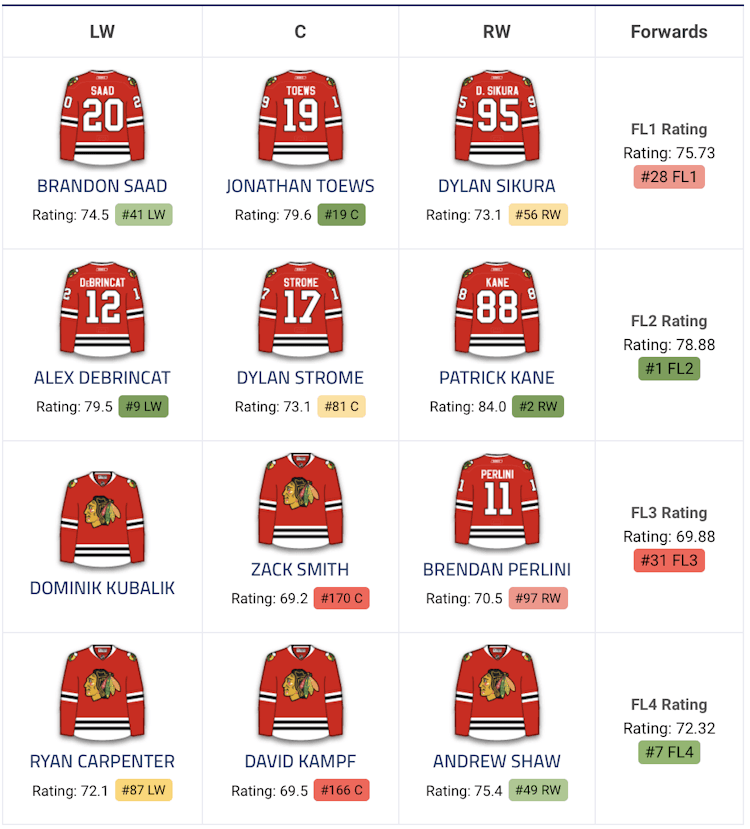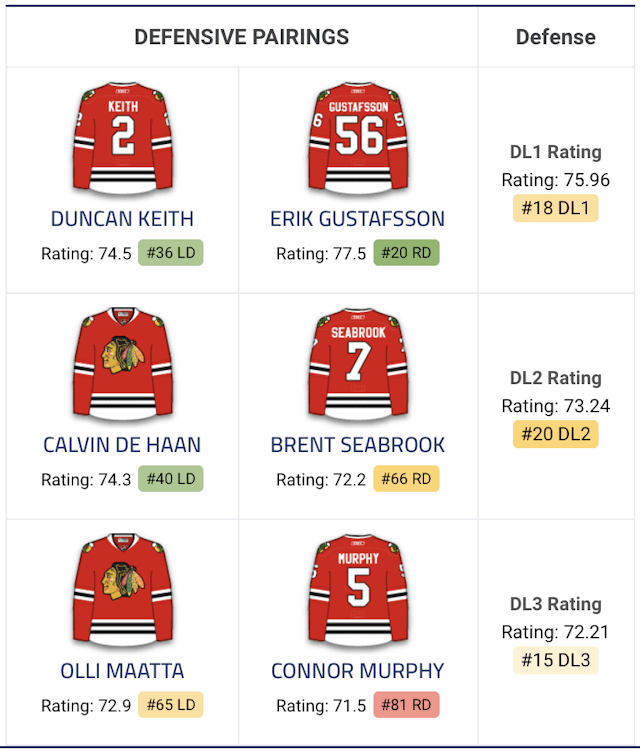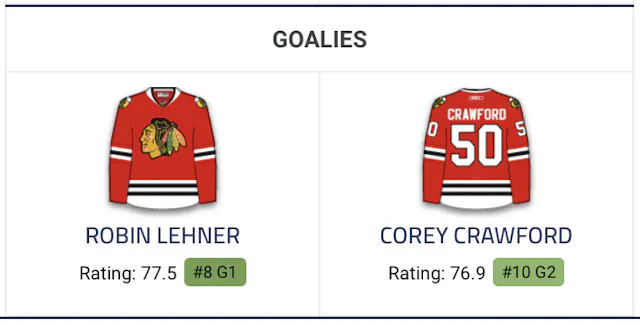2020 Fantasy Hockey Season Preview: Chicago Blackhawks


The 2018-19 Chicago Blackhawks were an offensive powerhouse with little to no regard for playing defense, finishing the season eighth in goals for but 30th in goals against. Only the Ottawa Senators surrendered more than Chicago’s 3.55 goals per game. Their fast and high-octane style of play certainly catered to the team’s strength. Chicago’s star-studded group of forwards was routinely let down by one of the worst bluelines in the league. The Blackhawks’ struggles on defense were amplified by some dreadful goaltending, a need they seemingly addressed in the off-season.
Chicago had a very active off-season. They addressed some concerns on defense and in goal while also adding some valuable depth pieces upfront. Their key additions include:
- — Robin Lehner (UFA): Signed a one-year, $5M contract.
- — Olli Maatta (Trade): Acquired for Dominik Kahun and a 2019 fifth-round pick.
- — Calvin de Haan (Trade): Acquired with Aleksi Saarela for Gustav Forsling and Anton Forsberg.
- — Andrew Shaw (Trade): Acquired for a 2020 second-round pick, a 2020 seventh-round pick, and a 2021 third-round pick.
- — Alexander Nylander (Trade): Acquired for Henri Jokiharju.
- — Zack Smith (Trade): Acquired for Artem Anisimov.
- — Ryan Carpenter (UFA): Signed a three-year, $3M contract.]
A shallow free-agent pool of defensemen turned Chicago to the trade market in hopes of solidifying their blue-line. The acquisitions of Maatta and de Haan were enough for Blackhawks GM Stan Bowman to feel comfortable swapping the young Jokiharju for Nylander. Given what was available, Chicago did an admirable job of addressing their weaknesses and was able to revamp their bottom-six group of forwards.
Forwards

For Chicago to make any significant progress in 2019-20, they’ll need their star group of forwards to replicate their success from a year ago. Patrick Kane (110), Jonathan Toews (81), Alex DeBrincat (76), and Dylan Strome (57) all posted career-highs in points last season. It was especially surprising for Toews and Kane, who were both in their aged-30 season. Chicago did their best to address the lack of depth this off-season, but this team could struggle to score if Kane and Toews fall back down to Earth.
Patrick Kane (RW)
- — Kane was the driving force behind Chicago’s offensive resurgence last season. He registered 44 goals and a career-high 66 assists in 81 games. The spike in goals was driven more by a spike in volume than percentage, which bodes well for his chances of topping 40 goals again in 2019-20. Kane fired a career-best 341 shots on goal while shooting 12.9%, right in line with his career mark of 12.1%. Last year’s 12.2% on-ice SH% suggests some slight regression is coming, but 100 points is still more than doable for Kane in 2019-20. There are only four or five players who have an argument for going ahead of Kane on draft day.
Alex DeBrincat (LW/RW)
- — DeBrincat has proven himself to be a sharpshooter over his two seasons in the NHL, but last year’s mark of 18.6% is going to be tough to repeat. Given his age, there’s plenty of reason to believe he can offset a dip in his SH% with an increase in shot volume. DeBrincat scored 41 times on 220 shots last season while playing 17:42 a night. The upside is there, but there’s more risk than I like to take on with a top-40 pick.
Jonathan Toews (C)
- — After posting three-straight sub-60-point campaigns, Toews exploded for 35 goals and 46 assists across a full 82 games last season. His sky-high usage gives Toews a sturdy floor to work with, but last season’s output was definitely his ceiling. His inconsistent shot volume from year to year brings more risk into the equation, but there’s only so far you can fall when playing a full season alongside Patrick Kane.
Dylan Strome (C)
- — Strome will need to take some major strides if he wants to come anywhere near the production he posted a season ago. After being acquired mid-season from the Arizona Coyotes, Strome posted 51 points in 58 games with the Blackhawks. While an increase in role and opportunity certainly played a part in his breakout, Strome was undoubtedly one of the most fortunate players in the league last season. He posted a 16.2% personal SH% with Chicago to go with an astounding 13.7% on-ice SH%. His role atop Chicago’s mighty power-play should keep his numbers afloat, but his 5v5 production is almost certain to take a hit. Of course, given his age, it’s plausible Strome could offset some of this regression with improvements to his peripheral numbers, most notably his shot volume and CF%.
Brandon Saad (LW)
- — All things considered, Brandon Saad had a disappointing year last season. He received ample playing time and opportunity with some of the best offensive talents in the NHL but was only able to tally 23 goals and 24 assists. There’s nothing in his underlying numbers that suggest a breakout is on the horizon, and Saad seems to have permanently forfeited his spot on the top power-play unit to Strome. He is a valuable depth piece for Chicago but should be an inconsequential player in standard fantasy leagues. At best he offers streaming value on the nights he slots in next to Toews and Kane.
Dylan Sikura (RW)
- — Dylan Sikura could be an interesting flier in deeper leagues. He underwhelmed in 33 games with Chicago last season, registering no goals and eight assists. Still, it’s believed Sikura could get an extended look in the top-six this season, and whoever ends up alongside Toews and Kane will be worth rostering. Sikura was a prolific scorer in the NCAA and posted an impressive 17 goals and 18 assists in 45 AHL games last season.
Defensemen

Chicago made some significant upgrades on defense, but they remain without a legitimate top-pair defenseman. Erik Gustafsson proved last year he is an elite offensive-defenseman, but his defensive numbers leave a lot to be desired. He works best in a sheltered role, evident by his 60.8% offensive-zone start percentage from last year. The steady decline of the 36-year-old Duncan Keith is showing no signs of stopping. Keith posted a career-low 50.0 CF% despite receiving similar deployment to Gustafsson. Despite all the changes they made on defense, Chicago’s blue-line looks to be their downfall again this season.
Erik Gustafsson (D)
- — One of the crowning achievements of Jeremy Colliton’s first season behind the bench was the diamond in the rough he uncovered in Gustafsson. Colliton identified Gustafsson as a weapon on the man advantage, leading to perhaps the most unpredictable breakout of the season. Gustafsson exploded for 17 goals and 43 assists in 79 games. His role atop Chicago’s dominant power-play is cemented and gives him a very stable floor, but 17 goals is unlikely to happen again if he can’t build on last year’s shot total of 160.
Duncan Keith (D)
- — Keith only managed three power-play points last season but was able to remain on the fringe of fantasy relevance thanks to a 10.2% on-ice SH%. Keith’s natural decline is at risk of being further amplified by limited opportunity and a potential dip in ice-time. There’s no reason for him to be taken in standard leagues on draft day.
Goalies

A good goaltender cures all, and Lehner offers a drastic improvement over Chicago’s goaltending from a year ago. The 28-year-old is coming off a career year with the Islanders, posting a .930 SV% and a 2.13 GAA in 46 appearances. His presence should allow the injury-prone Corey Crawford to produce in a more limited role. After playing just 27 and 39 games in each of the last two seasons, it was clear Crawford could no longer be counted on for a full workload. The addition of Lehner could make for one of the better timeshares in the league, like the success Lehner and Thomas Griess experienced a year ago.
Robin Lehner (G)
- — While a potential timeshare limits Lehner’s upside, we saw last year what he’s capable of in a reduced role. The defense in front of him is a concern, but the price seems to be right on Lehner early on. He’s being drafted on average as the 21st goaltender off the board in Yahoo! standard leagues. You could do a lot worse than Lehner as your number-two netminder.
Corey Crawford (G)
- — Crawford’s history with injuries over the last two seasons is a legitimate concern heading into 2019-20, but that should be eased by a lightened workload. Obviously, the injuries and the team’s spotty defense factored into Crawford’s underwhelming performance last season, but at 34-years-old, his age can’t be ignored either. We know what he’s capable of, but there’s far too much risk to trust Crawford as a starting fantasy netminder.
Projected Scoring Leaders
| Goals | Assists | Points | PPG | PPP |
| P. Kane (38) | P. Kane (58) | P. Kane (96) | P. Kane (10) | P. Kane (30) |
| A. DeBrincat (38) | D. Strome (40) | A. DeBrincat (70) | A. DeBrincat (10) | A. DeBrincat (19) |
| J. Toews (31) | J. Toews (38) | J. Toews (69) | J. Toews (7) | J. Toews (19) |
Blackhawks in the DFO Top 300
- 6 — Patrick Kane (RW)
- 42 — Alex DeBrincat (LW/RW)
- 54 — Jonathan Toews (C)
- 100 — Erik Gustafsson (D)
- 143 — Robin Lehner (G)
- 146 — Dylan Strome (C)
- 161 — Brandon Saad (LW/RW)
- 172 — Corey Crawford (G)
- 248 — Duncan Keith (D)
- 296 — Dylan Sikura (C/RW)
Season Outlook
| Central Division | |||
| 1 | |||
| 2 | |||
| 3 | |||
| 4 | |||
| 5 | |||
| 6 | CHICAGO BLACKHAWKS | 40-32-10 | 90 PTS |
| 7 |
The Blackhawks made their best effort to address some obvious weaknesses in the off-season, but it’s hard to imagine them leapfrogging many teams in the Central Division. They certainly got better, but none of the teams that finished above them got demonstrably worse. If the struggles persist on defense, it could be a long season in one of the most competitive divisions in hockey for the Hawks.